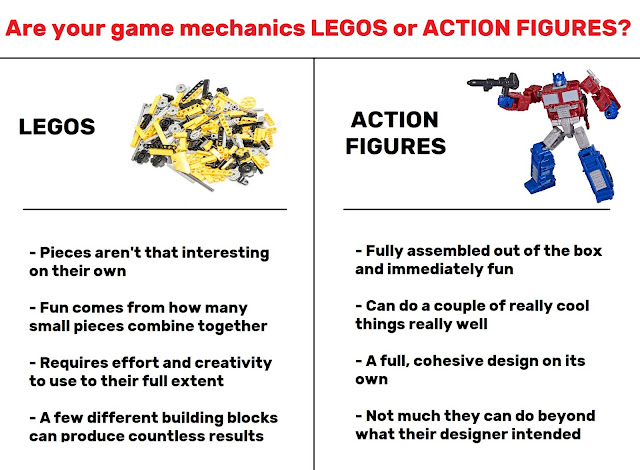UPDATED 10th July for greater clarity, thanks to feedback from Dan of Thrown of Salt
You might be familiar with the Lego analogy used for the design of roleplaying games.
 |
| Designers do some subtly disturbing shit with LEGO |
..but I came across it thanks to Monkeys Paw Games:
if you buy a lego set that has a castle on the front of the box and use the lego inside to build a spaceship are you playing lego "wrong?" are you told "no, idiot, you should have bought the spaceship lego, instead!"interesting interesting
As soon as the toy is in the hands of the child design intent goes out the window. No doubt the shiny picture on the box is what drew the child to the set in the first place, but the ultimate fate of all Lego is to join all the other bricks in the Big Box (the sandbox?) to make... to make whatever it is the child wants at a later date. In my experience—as a child and later a parent—the flashy box and instruction booklet end up lost or abandoned, surviving only as a vague impression in the child's mind, if at all.
Nonetheless, I thought the Lego analogy was an interesting starting point to explore how RPGs work, remembering Luka Rejec's post concerning toys and sandboxes. Like Lego's design team, the makers of RPG material are really only providing inspiration, and what ends up happening at the table is completely beyond their control.
Nonetheless, I thought the Lego analogy was an interesting starting point to explore how RPGs work, remembering Luka Rejec's post concerning toys and sandboxes. Like Lego's design team, the makers of RPG material are really only providing inspiration, and what ends up happening at the table is completely beyond their control.
Then I saw this stretching of the metaphor, and some fairly unimpressive acrobatics to attempt to shoehorn :
 |
| A false dichotomy |
As Monkey's Paw says, this image "fundamentally misrepresents both action figures and legos [sic]"
To be clear:
Now, an intermission
To be clear:
...and furthermore, who says Lego pieces aren't interesting on their own?
Now, an intermission
A Pataphor
A pataphor is an extended metaphor that develops its own context:
"Put another way, a pataphor is that which occurs when a lizard’s tail has grown so long it breaks off and grows a new lizard."
You see, words are bricks, too: we can take your crumby analogy and "instructions" and repurpose, detourner to our hearts content. Were we to apply a pataphysical transformation to the Lego analogy, here's what we'd get for an introduction to an RPG:
This book is like a Lego set, with instructions.You can follow them... or you can attempt to assemble the model by looking at the pictures on the box.Or can ignore the instructions entirely and assemble the pieces in whichever way you and your group feel is amenable.Or you can grind the bricks down into a powder and snort the dust and compose spontaneous ignu high poetry.
..and that's all I have to say on the subject.
Links
Monkey's Paw Games
Final note
Subscribe to the monthly Latest from the Labyrinth to keep up with Atelier Hwei/ Alone in the Labyrinth across multiple platforms

No comments:
Post a Comment